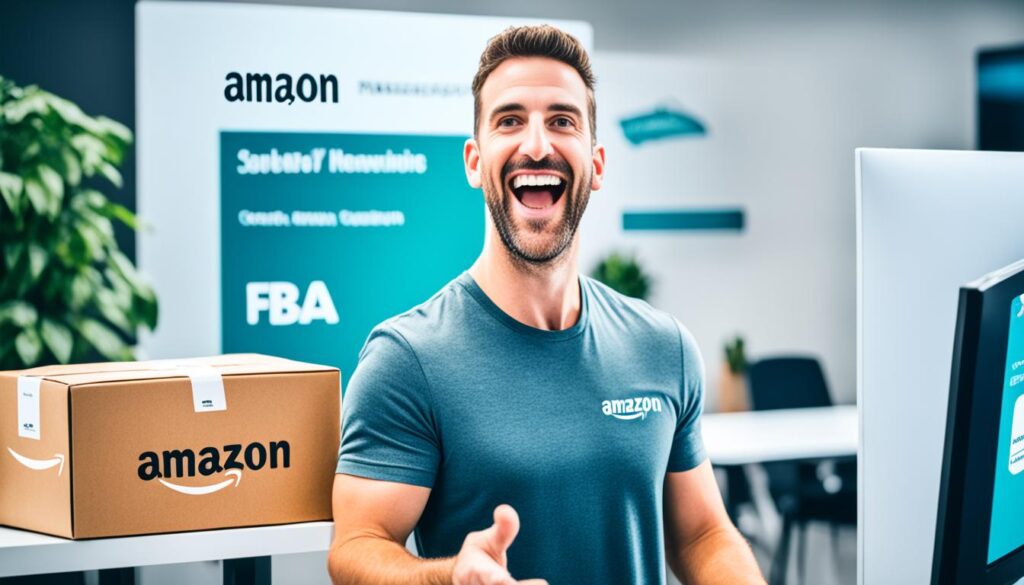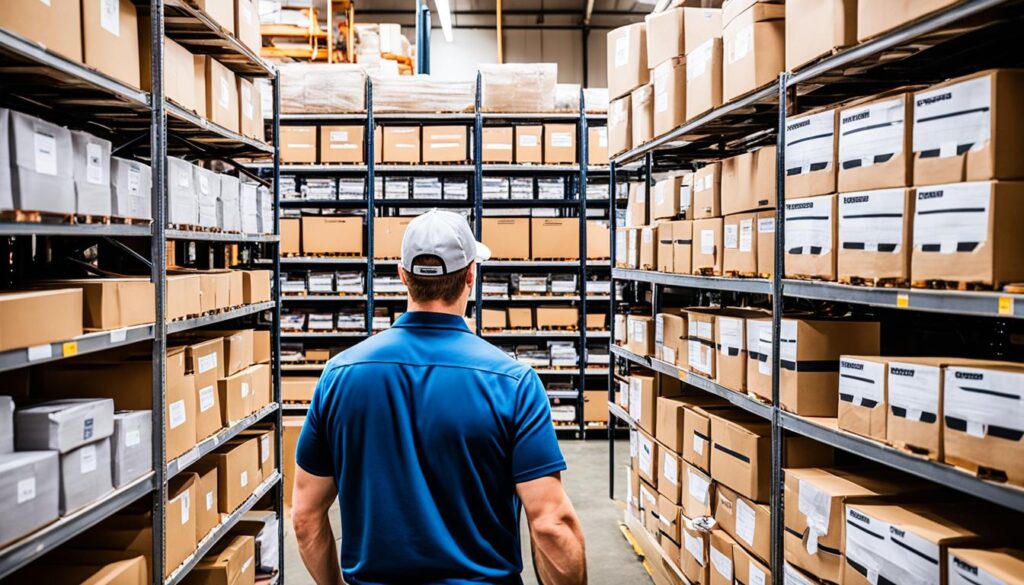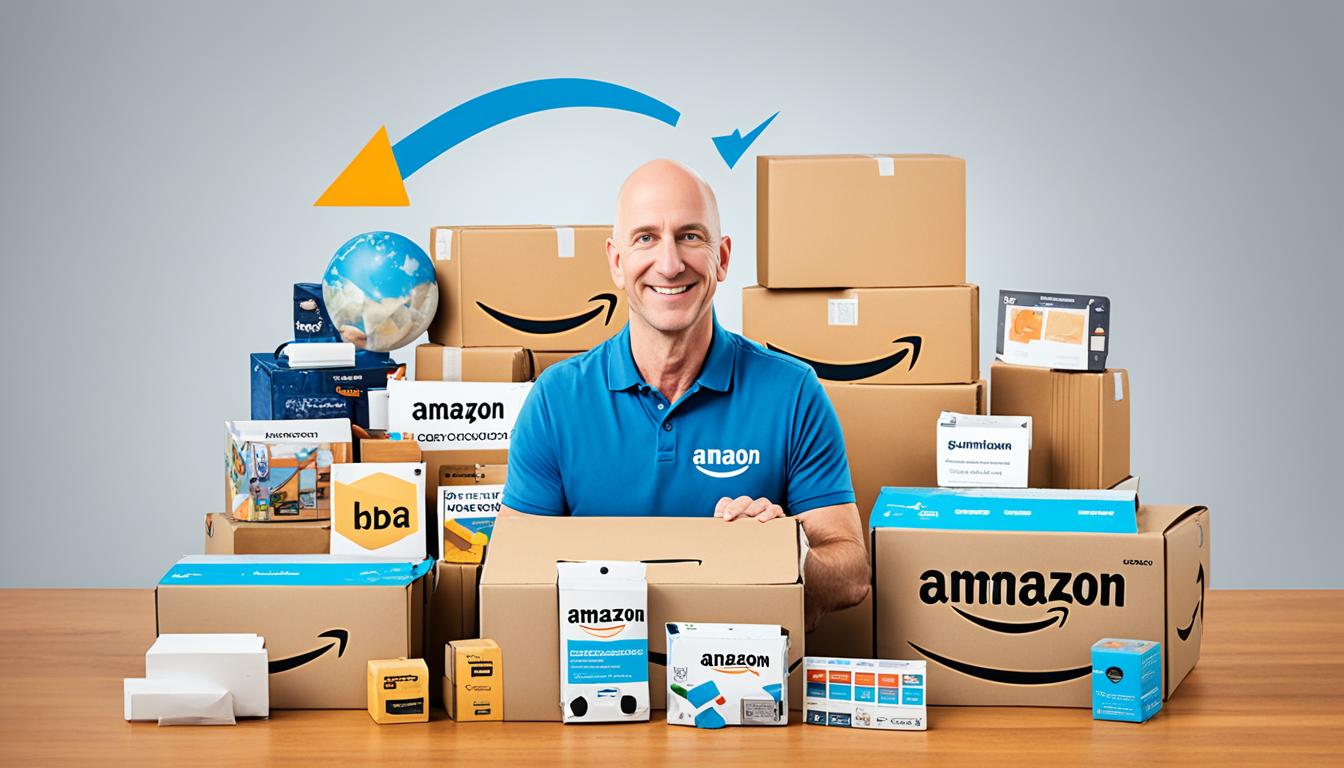In the online selling world, Amazon’s Fulfillment by Amazon (FBA) is changing the game. E-commerce makes up about 22% of worldwide sales and is only growing1. FBA helps businesses do better and reach more customers easily.
When you use FBA, Amazon stores your items in its warehouses. Then, Amazon does the hard work, like packing and shipping. This lets sellers spend more time on selling and less on logistics.
FBA makes it easier to sell and can boost your profits. Items with Amazon’s Prime shipping sell more, often 1.8 times more for certain items2. The ‘Buy with Prime’ tag also tempts new customers, increasing outside-of-Amazon sales by 25% on average2.
It’s also cheaper than some other shipping options. FBA shipping is 70% more affordable than top US services2. Plus, FBA lets you use Amazon Prime’s shipping benefits and save on shipping costs1.
This guide will dive deep into Amazon FBA. We’ll cover how to use it, its advantages, and the costs involved. Plus, we’ll give you detailed steps on how to start with FBA, ship products, and run a successful Amazon shop.
Key Takeaways
- Amazon FBA allows sellers to store products in Amazon’s fulfillment centers, with Amazon handling picking, packing, shipping, and customer service.
- FBA can lead to increased sales through Prime eligibility and Buy with Prime, which increases the chance of off-Amazon purchases.
- Shipping with FBA is more cost-effective than other premium fulfillment services in the US.
- FBA offers customizable programs, access to Prime shipping, and discounted shipping rates.
- This guide will cover how FBA works, its benefits, costs, and best practices for success as an Amazon seller.
What is Fulfillment by Amazon (FBA)?
Fulfillment by Amazon (FBA) is a service that lets sellers outsource their order processing. It includes packaging, shipping, and handling customer service to Amazon’s centers. This allows sellers to focus on their business growth. Amazon manages logistics to make customer experiences seamless.
How FBA Works
Sellers in the FBA program send their products to Amazon’s fulfillment centers. The products are stored until someone buys them. When a purchase is made, Amazon takes over. They pick, pack, and ship the item to the buyer. This also includes managing customer returns, making it easy for both sellers and customers.
The FBA program has two plans. The Individual plan costs $0.99 per item sold. The Professional plan is $39.99 per month3. Shipping with FBA usually costs less than using other big shipping companies. The standard fee Amazon takes from a sale is around 15-18%. Remember, extra costs may apply4.
For most products, FBA fees can be around 30-40% of the selling price, based on weight and size5. The referral fee is about 15%, no matter which fulfillment method you choose5. Amazon’s shipping partnerships can help you save money on shipping4.
Eligibility Requirements for FBA
To join FBA, sellers need an active Amazon account with products that fit Amazon’s rules. Most items are allowed, but there are restrictions for some, like dangerous goods or very big items.
It’s important to follow Amazon’s packaging rules. Items need to be packed and labeled correctly for Amazon’s centers. This helps ensure your products are ready for storage and shipping.
86% of third-party sellers use Fulfillment by Amazon (FBA) as their preferred business model5, while 22% of third-party sellers also use Fulfillment by Merchant (FBM) services5.
By following Amazon’s rules, sellers can enjoy the benefits of FBA. This includes more selling opportunities, lower costs, and reaching Amazon’s many customers. With FBA, sellers can offer quick and trustworthy delivery. It also cuts down on the time and effort needed to expand your business3.
Benefits of Using Amazon FBA
Amazon FBA helps sellers in many ways. It uses Amazon’s network to lower costs and boost sales. It also makes shipping and managing items simpler. This can lead to new chances for growth around the world.
Lower Fulfillment Costs
Using Amazon FBA can cut down on shipping expenses. The cost to fulfill an order can be between $3.07 and $161.11. This depends on the size and weight of the product6. These savings and Amazon’s quick delivery can make a big difference for sellers.
Increased Sales Potential
Amazon FBA can help sellers sell more. Most Amazon sales go through the Buy Box, which FBA users get to use, leading to more sales6. Amazon has even seen a 35% rise in sales for FBA sellers7. With over 200 million Prime members spending more on average than non-Prime members, selling through FBA can really build up sales8.
Simplified Logistics and Operations
Amazon FBA makes managing and shipping items easier. With more than 175 centers worldwide, Amazon looks after storing and sending out products for sellers7. This lets sellers concentrate on improving their products and advertising them better. Plus, Amazon offers constant customer and logistics help, making business growth smoother6.
Global Reach and Expansion Opportunities
FBA opens doors to the world for sellers. Amazon’s Global Selling Program lets sellers sell in 28 countries7. It connects sellers with millions of potential customers globally. Sellers can also use Multi-Channel Fulfillment to sell on other platforms like BigCommerce and eBay while Amazon takes care of shipping6.
| Benefit | Description |
|---|---|
| Lower Fulfillment Costs | Competitive FBA fees ranging from $3.07 to $161.11 per item, depending on dimensions and weight6 |
| Increased Sales Potential | Access to the Amazon Buy Box, 35% increase in sales for FBA sellers, and a 200 million-strong Prime membership community678 |
| Simplified Logistics and Operations | Amazon handles storage, packaging, and shipping, with over 175 fulfillment centers worldwide and 24/7 customer support67 |
| Global Reach and Expansion Opportunities | Access to Amazon’s Global Selling Program in 28 countries and Multi-Channel Fulfillment for sales across various platforms67 |
Costs Associated with Amazon FBA
Using Amazon FBA for your business comes with several costs. It can make handling orders easier and offer many perks. But, you need to think about the costs to make sure you’ll earn money. Next, we’ll dive into the main costs you might face with FBA.
Fulfillment Fees
One big cost with Amazon FBA is the fulfillment fees. These fees handle preparing and shipping your products, as well as customer service and returns9. The fees are based on how big and heavy your items are109. In April 2024, Amazon changed its rates for different product sizes, making them lower for some10.
Also, Amazon charges a referral fee to all sellers. It’s a small percentage of the sold item’s price, no matter how it was shipped9. This fee changes, from 8% to 45%, but most categories have a minimum of $0.301011.
Storage Fees
Storage costs with Amazon FBA are also important. You pay for how much space your items take up each month, plus, if you have stock that doesn’t sell quickly, there’s an extra fee10. The regular storage fees can change with the season and what kind of items you sell, but they’re between $0.56 and $3.34 per cubic foot9. From April 1, 2024, Amazon cut the cost for storing items that don’t sell fast10.
If you keep your items in Amazon’s warehouses for a long time, you’ll also pay more. These extra charges get added after your items have been there for a year, and they got more expensive on February 15, 202410. They range from $0.50 to $6.90+ per cubic foot, based on the time your items have been there9.
Additional Costs to Consider
There are more costs to think about with Amazon FBA:
- As a seller on Amazon, you pay $0.99 for each sale if you’re an individual. Pros pay $39.99 monthly10.
- Amazon also takes a refund fee of $5.00 or 20% of the refunded amount, depending on which is smaller10.
- Plus, there are extra fees for having too much inventory, sending items back to you, deleting inventory, certain services, preparing packages, and not following the rules9.
For a good idea of your costs and if you’ll make money, try the FBA Revenue Calculator. It helps compare FBA with other ways of filling orders.
Your total Amazon FBA costs can vary a lot. It depends on what you sell, when, and how much. But, with smart planning, you can do well on Amazon by understanding these costs9.
Getting Started with Amazon FBA
Becoming an Amazon FBA seller allows you to reach more customers. The Amazon marketplace is huge, making it a great place to sell. With over half of U.S. consumers starting their searches on Amazon12, sellers can grow their business significantly here.

To start, create a selling account on Amazon and pick a plan. You can choose between the Individual plan or the Professional plan. The Individual plan charges $0.99 per sale. The Professional plan costs $39.99 each month13. After picking a plan, you can start using the FBA program. This allows you to create new listings or switch your current ones to FBA.
Make sure you follow all the rules and policies before listing your products13. There might be different rules for various product types. You might also need special permission to sell certain items. Amazon uses a Global Trade Item Number (GTIN), like a UPC, to link your product to the correct page13.
The FBA program lets sellers add as many or as few products as they want. New sellers can get shipping, returns, and other perks2.
Choosing FBA as your fulfillment method has several benefits:
- It costs 70% less to ship with FBA compared to other U.S. services2.
- Items with Prime are 25% more likely to be bought by customers not browsing on Amazon at the time2. Offering discounts through Subscribe & Save can increase sales conversion by up to 1.8X on average2.
- You only pay for what you use. FBA charges are based on your sales2.
Plan to sell products priced between $20 and $70 for the best margins12. The most popular product categories on Amazon include Home & Kitchen, Beauty & Personal Care, and Clothes12.
Preparing and Shipping Inventory to Amazon
An efficient product preparation for FBA is key. Be sure to follow Amazon’s guidelines. They help reduce transport damage and make your items ready for buyers fast after arriving at Amazon centers14.
Product Preparation Guidelines
Follow Amazon’s FBA packaging, prep, and labeling steps when getting your goods ready for Amazon’s centers. Use good packaging, such as boxes and bubble wrap, to keep your items safe during transit14. Also, you’ll need a printer for making product labels and barcodes14.
You can add inventory in two ways according to Amazon: through case-pack templates or individual units14. Case-pack templates, for instance, can be reused. They make future shipments smoother and quicker since you won’t have to type in all the details again14.
Labeling and Packaging Requirements
Getting the labeling and packaging right is crucial. Each item should have a unique Amazon barcode, which you can print from Seller Central14. Make sure all labels are stuck on well and clearly show the essential details.
Always follow these rules for packaging your items:
- Choose sturdy packaging that keeps your items safe
- Use tape to seal packaging to avoid loss
- Don’t overdo the wrapping; it cuts waste and costs
- Ensure your package opens easily without damaging the product
Creating Shipments to Amazon Fulfillment Centers
Once everything is prepared and labeled, head to the Send to Amazon section in Seller. Here, you can set up your shipment. This part is made easy with step-by-step directions, offering perks like saving templates, choosing shipping easily, and getting discounts on shipping costs15.
Adding a shipment needs you to give accurate shipping info, like when it’s shipping, how much it might cost, and which carrier to use. This helps make the shipping smooth and avoids delays14. You can pick from different types of shipping, like Small Parcel Delivery (SPD) or Less-than Truckload (LTL), offering you shipping options14.
The Send to Amazon plan has five main steps. These include picking what to send, packing the units, checking the shipping details, printing the box labels, and, for pallets, confirming the carrier and pallet info, and then printing pallet labels15. Sellers, like Buttonsmith, say shipping to Amazon is easier and faster this way, even with lots of different items to send each week15.
Remember, Amazon’s partnered carriers, like UPS, often have the best shipping prices16. Amazon’s Global Logistics program lets sellers like you book ocean shipments from China to Amazon centers straight from Seller Central. This move makes importing goods easier16.
Managing Inventory and Orders with FBA
Good FBA inventory management is key to keeping the right amount of stock. It helps the fulfillment process run smoothly. Sellers can use Amazon’s tools to manage inventory well. This allows them to focus on growing their business. Amazon has over 175 fulfillment centers worldwide. They cover more than 288 million square feet. This makes it easy to pick and pack products fast17.

Inventory Management Best Practices
To do well in FBA inventory management, here’s what sellers should do:
- Keep an eye on inventory and get alerts when it’s time to restock
- Store about 2 months’ of inventory at Amazon’s fulfillment centers
- Raise stock amounts during busy sales times
- Use Amazon’s Veeqo software for free. It helps keep track of inventory across different platforms and FBA18
- Don’t keep too much stock. Amazon says it’s too much if it’s over 90 days or over 90 days old18
Monitoring Stock Levels and Reordering
The FBA Inventory page in Seller Central lets sellers watch and restock their goods. The FBA Dashboard gives a big picture of sales, shipments, and opportunities. By estimating sales and watching how fast items sell, sellers avoid having old stock. This is stock that doesn’t sell quickly or at full price18. An inventory system can forecast sales to have the right amount of stock during holidays and big sales times18.
Sellers can ask for more warehouse space by paying a “reservation fee”. Those who offer to pay more get priority over others19. If your professional account is at least 39 weeks old, how much space you get depends on your IPI score. A high score means you can store more19.
Handling Returns and Refunds
Amazon takes care of returns and refunds for FBA orders. This lets sellers focus on their main goals. They can control these processes through Seller Central. Over two-thirds of U.S. shoppers want their items in three days or less after buying them. Also, nearly 70% of online buyers don’t like it when their order is late. FBA’s fast service helps meet these high expectations19.
By using Multi-Channel Fulfillment (MCF), sellers can have their orders filled from different sales channels18. The Subscribe & Save program from FBA boosts sales and keeps customers coming back18. Plus, sending items through FBA is 30% cheaper than standard shipping. It’s also 70% cheaper than premium shipping18.
Maximizing Success with Amazon FBA
To ensure selling success with Amazon FBA, you need to focus on a few key things. These include making your product listings better, using Amazon’s customer service well, and managing returns with expertise. By following these strategies, you can better your chances of success on Amazon long-term.
Optimizing Product Listings for FBA
Improving your product listings is very important for Amazon FBA success. Make sure your products’ dimensions are right. Use quality images to show off your items. And create titles and descriptions that draw in buyers. This will help your products get seen more, bringing in more sales. Remember, tools like Jungle Scout and Helium 10 can help you find the best items to sell on Amazon FBA20.
Leveraging FBA for Multi-Channel Fulfillment
Also, you can grow your Amazon FBA success by using it for more than just the Amazon site. You can fulfill orders not only on Amazon but also on your website or other marketplaces. This lets you offer a consistent experience to all buyers. And remember, Amazon’s revenue of over $141 billion is partially due to sellers using FBA21.
“86% of Amazon’s third-party sellers opt for FBA for order fulfillment within their businesses.”20
Utilizing Amazon’s Customer Service and Returns Management
Lastly, use Amazon’s customer service and returns support to your advantage with FBA. Amazon handles customer issues, returns, and refunds for your FBA items. This saves you time and lets you focus on growing your business. Great customer service leads to more positive reviews, better sales, and happy customers21.
Keep an eye on your FBA operations, Amazon rules, and best practices. With the right focus, these steps can lead your business to success in e-commerce. Whether you’re starting with FBA or improving your current efforts, these steps are essential. They will help you meet your goals and thrive in online sales2221.
Conclusion
Amazon FBA changes the e-commerce game for sellers. It helps them work more efficiently and expand their businesses. With Amazon’s backing, they can cut costs, boost sales, and concentrate on growing their brand23.
In 2023, 86% of sellers preferred using FBA for fulfilling orders24. This shows the big rewards it offers. It’s better on the pocket too, with about 70% off on top shipping and 30% on regular shipping24.
But, starting with FBA means looking closely at the expenses. You have to think about the fees for how big or heavy your products are, the monthly storage costs, and charges for keeping items over a year25. You also need to prep your products right and handle your stock well to dodge extra fees and keep making money23.
The challenges are there, but so are the benefits. Like being Prime eligible, reaching millions of Amazon customers, and giving quick, free shipping232425. These perks often make FBA the top choice for sellers.
To really win with Amazon FBA, sellers need to smarten up their product listings. They should also try using Amazon for more than just one channel. Plus, making the most of Amazon’s support and handling returns right can make a big difference. By staying on top of these approaches, any seller can make the most of FBA. It can truly boost their online sales and help them stand out in the busy e-commerce world.
Source Links
- A Guide to Amazon FBA – Is Fulfillment by Amazon Right for You?
- Amazon FBA for beginners
- Is Amazon FBA worth it? What to consider – Sell on Amazon
- Fulfillment By Amazon (FBA)
- What is Fulfillment By Amazon (FBA)? Definition & Examples
- Amazon FBA: How it Works + Cost and Maximizing Sales
- MY FBA PREP
- The Many Benefits of FBA
- Amazon FBA Fees Explained: A Guide to FBA Seller Costs in 2024
- Amazon FBA Fees: How Much Does it Cost to Sell on Amazon in 2024?
- How much does it cost to sell with Amazon?
- How to Sell on Amazon FBA for Beginners – 2024 Guide | Jungle Scout
- How to sell on Amazon | A guide for beginners
- How to send your inventory to Amazon Fulfillment Centers
- Send to Amazon simplifies shipments for Fulfillment by Amazon sellers – Sell on Amazon
- How to Ship Directly to Amazon FBA in 2024: Step-by-Step Guide
- Behind The Scenes of Amazon Inventory Management
- Inventory Management
- Amazon Inventory Management – 2023 Strategy & Automation – Jungle Scout
- What’s the Amazon FBA Success Rate in 2024: Sellers Guide
- Five Tips To Run a Successful Amazon FBA Business
- How Amazon FBA Works & Ways to Maximize It in 2024
- Understanding Amazon FBA: Advantages and Disadvantages for Sellers
- Amazon FBA Explained: Navigating the Benefits and Drawbacks for Online Sellers
- Is Amazon FBA Worth It for Sellers in 2024? – Seller Sessions Podcast


